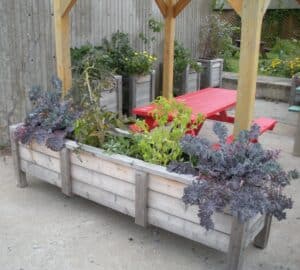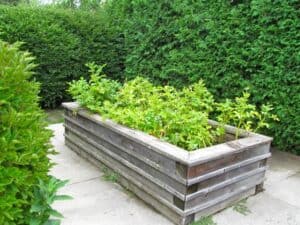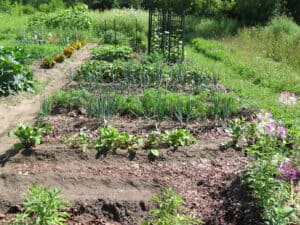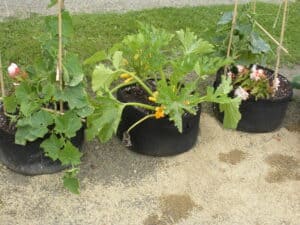Article, photos, and graphics by Rob Danforth

Plan your garden for rotation of all annuals and, from time to time, some perennials for both soil and plant health.
Planting the same plant in the same spot year after year invites problems with insects and diseases. These take up residence in the soil next to the plants that support them (e.g., tomato blight, Japanese Beetles). Planting vegetables, herbs, and flowers in different spots each year helps the plants to thrive and removes them from the dangers in the soil.
Plants also remove nutrients from the soil and can exhaust the soil in both plot and pot. Different plants take different elements at different depths in the soil. Heavy feeders (e.g., tomatoes, corn — the larger the plant and fruit, the heavier the feeder) remove a lot of nutrients. Around Ottawa, the fields have corn one year and soybeans the next: corn takes a lot away; soybeans put some back. In containers, the limited amount of nutrients in the garden soil or potting mix, is removed also by top watering the plants.

Compost is a slow-release fertilizer that has all that plants need from A to Z. Chemical fertilizers tend to have a very few targeted elements in large quantities like 10-10-10 for your lawn where there are 1000’s of hungry plants to take up the plant food. Excess nutrients from chemical fertilizers get washed away by water and can end up in our rivers where they will remove oxygen (e.g., algae blooms). Urban gardens have, at best, 10’s of well spaced, well pampered plants, so compost with low NPK numbers (e.g., 0.5-0.5-0.5) and many trace elements serve plants constantly and do not provide excess nutrient that can be easily washed away.
Planting different plants each year and adding compost or composted manure allows the soil time to recover its nutritional value and re-balance the pH.
One can argue that an exception would be perennials; however, they too can be susceptible to all the problems that annuals face. We have moved some perennials (rhubarb, gooseberries, strawberries, black currents, herbs, flowers) after a time, when they began to look tired and offer a lack-luster performance. They flourished in their new locations just like new plantings. Of course, fertilizing with compost every year was and is a must since we do not rotate them every year as we do annuals.
Tip: one can also split and transplant sections of perennials to new locations for succession planting and rotation combined.
Rotation suggestions:
Divide your in-ground garden or raised bed into quadrants or fixed rows and rotate the plants through the quadrants or move the plants at least two or three rows every season (i.e., do not rotate plants from one row to the next row near it – allow at least 3 rows distance).

The simplest rotation is heavy feeders (e.g., corn, tomatoes, vine plants) followed by light feeders (e.g., leafy greens, root vegetables), followed by legumes (e.g., peas, beans). Of course, before deciding on your quadrants or rows, check companion plantings to be sure you are not combining bad companions or planting in soil previously inhabited by bad companions (e.g., do not plant beans right after garlic or onions).
For large containers, like box beds and elevated beds, add some smaller containers like “potato bags” or fabric grow bags so your favoured plants can be grown in satellite pots for 2 seasons.

The minimum recommended rotation time is three seasons, to let soil recover and problems to be resolved. Longer would be better but not very practical for most urban gardeners.
Rotation can spruce up the garden and your gardening. It takes a bit of research and planning, but once done, it is really quite easy to implement. Keep your plants happy and keep the bugs and diseases guessing! Happy Gardening!